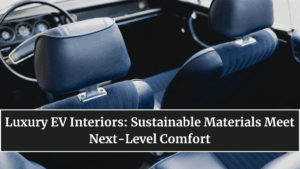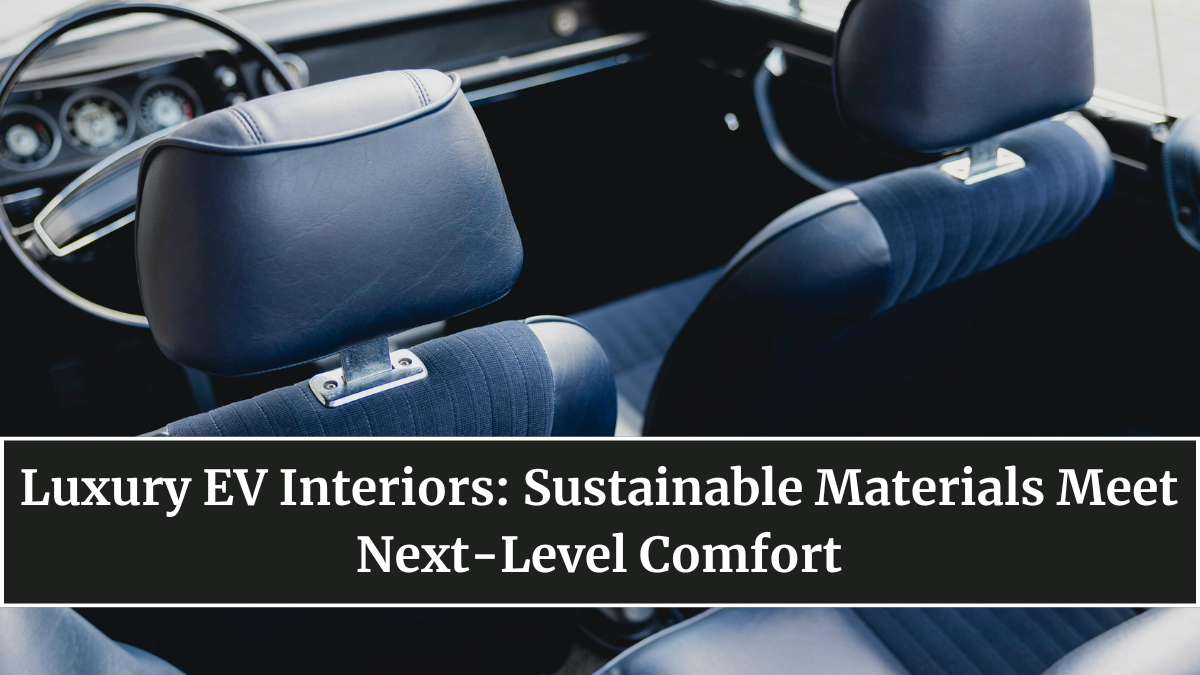The definition of luxury in automobiles has changed forever. In 2025, luxury EV interiors blend premium design, cutting-edge technology, and sustainability in ways that redefine comfort and craftsmanship. As electric vehicles dominate the high-end market, automakers are focusing not just on performance but on creating immersive cabin experiences powered by eco-friendly innovation and intelligent design.

The Evolution of Interior Luxury
For decades, luxury car interiors symbolized opulence through leather, wood, and chrome finishes. Today, the luxury lies in sustainability, personalization, and digital integration. Electric vehicles have reimagined cabin layouts by eliminating engine tunnels and mechanical gear levers — opening up space for lounge-like interiors that feel more like premium living rooms than traditional cars.
Manufacturers like Mercedes-Benz (EQS), Lucid Motors, Tesla, and BMW’s i7 are leading this revolution with panoramic displays, ambient lighting, and minimalist aesthetics crafted from responsibly sourced materials.
Sustainable Materials Take Center Stage
Modern luxury now prioritizes sustainability. The shift from animal leather to vegan and recycled materials has become a defining trend in 2025’s luxury EV interiors. Designers are embracing materials like:
-
Recycled ocean plastics for panels and fabrics.
-
Plant-based vegan leather alternatives such as Ultrafabrics and Apple-derived materials.
-
Sustainably sourced wood veneers and recycled aluminum trims.
-
Natural fibers like bamboo and wool for breathable comfort.
This transformation reflects a growing demand for eco-conscious luxury—proof that elegance can coexist with environmental responsibility.
The Role of Technology in Cabin Experience
Luxury EV cabins have evolved into digital sanctuaries powered by AI and smart connectivity. Massive OLED dashboards, AI-driven voice assistants, and augmented reality (AR) head-up displays create a futuristic yet personalized atmosphere.
For instance, the Mercedes EQS Hyperscreen offers a seamless glass interface that spans the entire dashboard, while BMW’s Interaction Bar transforms lighting and controls into a single adaptive strip. These features adapt to mood, driving style, and even weather — ensuring every journey feels curated.
Moreover, intelligent climate systems now use AI to learn passenger preferences, adjusting seat temperature, fragrance diffusion, and lighting to create a truly personalized environment.
Acoustic and Comfort Innovation
Electric drivetrains eliminate engine noise, allowing automakers to focus on acoustic luxury — the art of silence. Engineers now use sound-dampening materials and active noise cancellation systems to ensure near-silent cabins. Some EVs even allow drivers to choose artificial engine sounds or ambient soundscapes for an emotional driving experience.
Seats, meanwhile, have become wellness zones. Features like massaging lumbar supports, temperature regulation, and posture correction are controlled via touch or voice. Some brands even incorporate biometric sensors to track driver fatigue and adjust lighting or music to maintain alertness.
Personalization Through AI and Connectivity
With connected car ecosystems, luxury EV interiors have become deeply personalized digital spaces. Drivers can sync their preferences via profiles stored in the cloud — from seating position and screen layout to playlists and color themes.
AI systems also analyze driving habits and calendar data to suggest routes, reminders, or relaxation settings during long drives. Integration with smart homes means drivers can adjust lights or security systems directly from their car dashboard.
This fusion of mobility and lifestyle transforms the cabin into an intelligent, responsive environment tailored to each occupant.
The Future of Luxury Interiors
By 2025 and beyond, the focus of luxury EV interiors will move toward adaptive architecture, biometric comfort systems, and sustainable craftsmanship. Expect interiors that evolve dynamically — from workspace setups during commutes to lounge modes for relaxation.
The ultimate goal for automakers is to merge sustainability, serenity, and sophistication into one seamless experience. The next generation of luxury EVs will not just transport passengers — they’ll elevate their state of mind.
FAQs
What defines a luxury EV interior in 2025?
A combination of sustainable materials, AI-powered comfort, and cutting-edge digital integration that delivers both elegance and innovation.
Which materials are used in premium EV interiors today?
Brands use vegan leather, bamboo, recycled plastics, and natural fibers instead of traditional materials to reduce environmental impact.
How does AI enhance luxury interiors?
AI personalizes climate, seating, lighting, and infotainment systems based on user preferences, making each drive more comfortable and efficient.
Are electric luxury cars quieter than petrol ones?
Yes. The absence of engines allows for enhanced noise insulation, creating a peaceful, near-silent driving environment.
What is the future of luxury EV design?
The future focuses on adaptive interiors, sustainable innovation, and fully immersive AI environments, blending comfort with conscious design.
